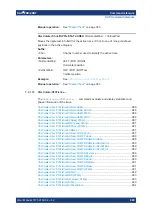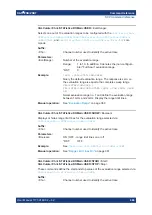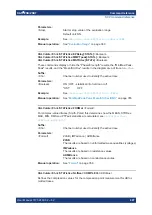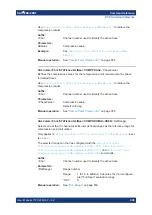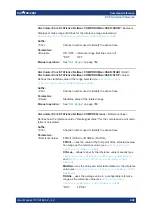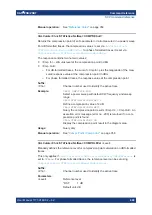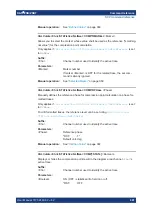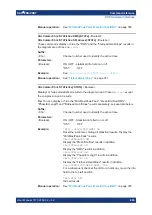
Command reference
R&S
®
ZNB/ZNBT
999
User Manual 1173.9163.02 ─ 62
CALCulate<Chn>:TRANsform:DTFault:SELect
<DtfSelectCable>
Selects one of the available (predefined or user-defined) cable types for Distance to
Fault measurements.
Suffix:
<Chn>
.
Channel number used to identify the active trace.
Parameters:
<DtfSelectCable>
Name of the cable type.
Example:
CALCulate1:TRANsform:DTFault:SELect '5088-HFLR'
Selects cable type "5088-HFLR".
Options:
R&S
ZNB/ZNBT-K3
Manual operation:
See
CALCulate<Chn>:TRANsform:DTFault:STARt
<Start>
CALCulate<Chn>:TRANsform:DTFault:STOP
<Stop>
Defines the window of the Distance to Fault measurement using its start and stop dis-
tance.
See also
CALCulate<Chn>:TRANsform:DTFault:CENTer
CALCulate<Chn>:TRANsform:DTFault:SPAN
.
Suffix:
<Chn>
.
Channel number used to identify the active trace
Parameters:
<Start>/<Stop>
Start/stop distance.
Default unit: m
Example:
:CALCulate1:TRANsform:DTFault:STARt 1; STOP 3
Defines the DtF distance window of the active trace of channel 1
as [1m, 3m].
Options:
R&S
ZNB/ZNBT-K3
Manual operation:
See
"Start Distance / Stop Distance"
CALCulate<Chn>:TRANsform:DTFault:STATe
<DtfState>
If channel <Chn> is performing an unsegmented frequency sweep, this command
allows to transform its active trace into a Distance to Fault (DtF) trace.
Suffix:
<Chn>
.
Channel number used to identify the active trace
Parameters:
<DtfState>
OFF|ON – DtF disabled|enabled
*RST:
OFF
Example:
:CALCulate1:TRANsform:DTFault:STATE ON
turns the DtF representation of the active trace of channel 1 ON.
SCPI command reference

